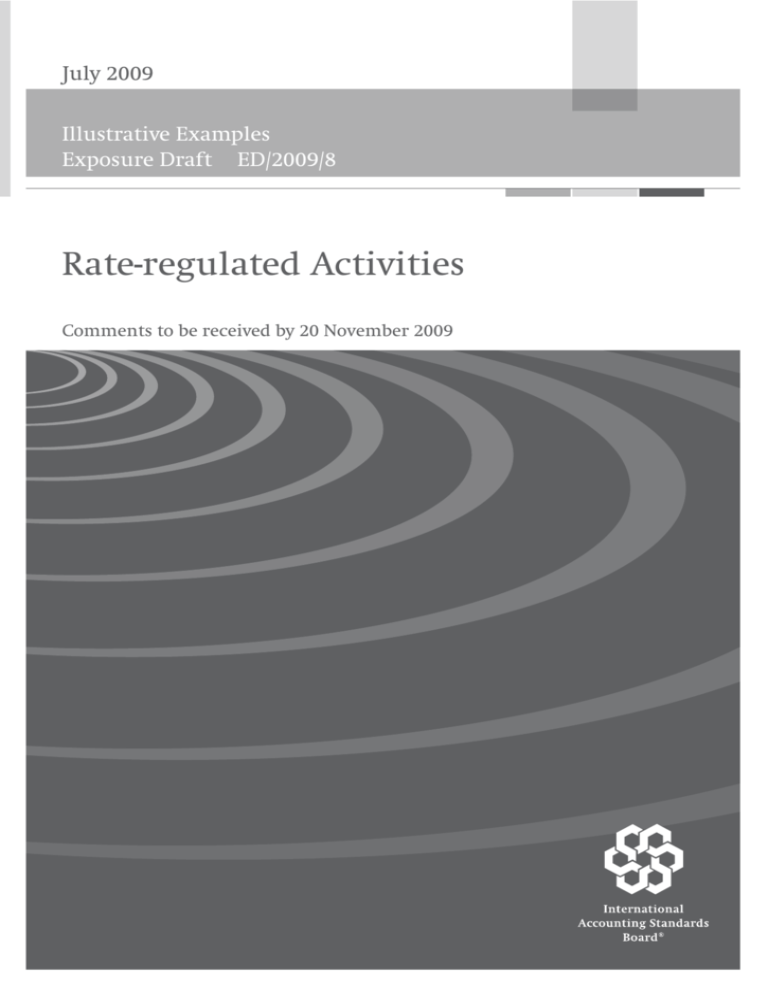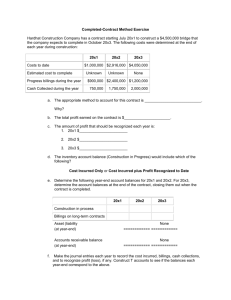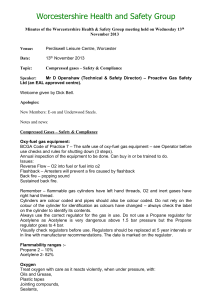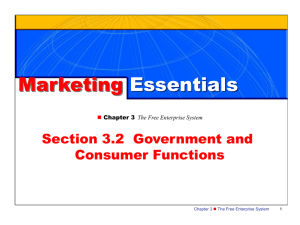
July 2009
Illustrative Examples
Exposure Draft ED/2009/8
Rate-regulated Activities
Comments to be received by 20 November 2009
Draft Illustrative Examples
Exposure Draft
RATE-REGULATED ACTIVITIES
Comments to be received by 20 November 2009
ED/2009/8
These draft Illustrative Examples accompany the proposed International
Financial Reporting Standard (IFRS) set out in the exposure draft Rate-regulated
Activities (see separate booklet).
Comments on the draft IFRS and its
accompanying documents should be submitted in writing so as to be received by
20 November 2009. Respondents are asked to send their comments electronically
to the IASB website (www.iasb.org), using the ‘Open to Comment’ page.
All responses will be put on the public record unless the respondent requests
confidentiality. However, such requests will not normally be granted unless
supported by good reason, such as commercial confidence.
The International Accounting Standards Board (IASB), the International
Accounting Standards Committee Foundation (IASCF), the authors and the
publishers do not accept responsibility for loss caused to any person who acts or
refrains from acting in reliance on the material in this publication, whether such
loss is caused by negligence or otherwise.
Copyright © 2009 IASCF®
ISBN for this part: 978-1-907026-28-7
ISBN for complete publication (set of three parts): 978-1-907026-25-6
All rights reserved. Copies of the draft IFRS and its accompanying documents may
be made for the purpose of preparing comments to be submitted to the IASB,
provided such copies are for personal or intra-organisational use only and are not
sold or disseminated and provided each copy acknowledges the IASCF’s copyright
and sets out the IASB’s address in full. Otherwise, no part of this publication may
be translated, reprinted or reproduced or utilised in any form either in whole or
in part or by any electronic, mechanical or other means, now known or hereafter
invented, including photocopying and recording, or in any information storage
and retrieval system, without prior permission in writing from the IASCF.
The IASB logo/the IASCF logo/‘Hexagon Device’, the IASC Foundation Education
logo, ‘IASC Foundation’, ‘eIFRS’, ‘IAS’, ‘IASB’, ‘IASC’, ‘IASCF’, ‘IASs’, ‘IFRIC’, ‘IFRS’,
‘IFRSs’, ‘International Accounting Standards’, ‘International Financial Reporting
Standards’ and ‘SIC’ are Trade Marks of the IASCF.
Additional copies of this publication may be obtained from:
IASC Foundation Publications Department,
1st Floor, 30 Cannon Street, London EC4M 6XH, United Kingdom.
Tel: +44 (0)20 7332 2730 Fax: +44 (0)20 7332 2749
Email: publications@iasb.org Web: www.iasb.org
DRAFT ILLUSTRATIVE EXAMPLES JULY 2009
CONTENTS
paragraphs
RATE-REGULATED ACTIVITIES
[DRAFT] ILLUSTRATIVE EXAMPLES
IE1–IE38
APPLICATION OF THE SCOPE
IE1–IE17
Example 1 – Example of rate-regulated operations
IE1–IE4
Example 2 – Incentive-based regulation in energy
transmission and distribution
IE5–IE9
Example 3 – Supply of energy in a rate-regulated environment
IE10–IE12
Example 4 – Cost-of-service regulation with a determinable
variable return
IE13–IE14
Example 5 – Example of price cap regulation
IE15–IE17
RATE-REGULATED ASSETS AND LIABILITIES
IE18–IE21
Example 6 – Example of a regulatory asset
IE18–IE21
OTHER EXAMPLES
IE22–IE38
Example 7 – Determination of the regulated rate
IE22–IE24
Example 8 – Balancing account
IE25–IE34
Example 9 – Regulatory liability
IE35–IE38
3
© Copyright IASCF
RATE-REGULATED ACTIVITIES
IFRS X Rate-regulated Activities
[Draft] Illustrative examples
These examples accompany, but are not part of, the draft IFRS.
The Board plans to publish examples 1–6 with the IFRS. Examples 7–9 are included in the
exposure draft to help respondents.
Application of the scope
Example 1 – Example of rate-regulated operations
IE1
Company X, the owner of electricity transmission infrastructure and
related assets, has been licensed for twenty years to operate a
transmission system in a particular jurisdiction. Only one operator is
authorised to manage and operate the transmission system.
IE2
Company X charges its customers for access to the network at prices that
must be approved by the regulator. Pricing structures are defined in the
law and related guidelines, and are determined on a ‘cost plus’ basis that
is based on budget estimates. Once approved, prices are published and
apply to all customers. Prices are not negotiable with individual
customers.
IE3
Prices are set to allow Company X to achieve a fair return on its invested
capital and to recover all reasonable costs incurred. At the end of each
year, Company X reports to the regulator deviations between the actual
and budgeted results. If the regulator approves the differences as
‘reasonable costs’, they are included in the determination of rates for
future periods.
IE4
Such rate-regulated activities are within the scope of the [draft] IFRS
because the regulator establishes the prices Company X charges its
customers, those prices bind the customers, and the prices are designed
to recover Company X’s specific costs and earn a fair return.
© Copyright IASCF
4
DRAFT ILLUSTRATIVE EXAMPLES JULY 2009
Example 2 – Incentive-based regulation in energy
transmission and distribution
IE5
Company Y operates in a jurisdiction where revenue rather than rates is
regulated for energy distribution. The regulator sets a total ‘allowable
revenue’ for each year. To the extent that Company Y collects more or less
than the allowable revenue in any year, it must adjust its prices for the
following year.
IE6
The regulator resets allowable revenue every five years after reviewing
every entity in the industry and taking into account the differences
in their operations and geographical distribution of customers.
The regulator then determines for each entity:
(a)
an efficient level of operating costs;
(b)
an agreed programme of capital expenditure over the next five
years; and
(c)
a cost of capital.
IE7
Allowable revenue for the first year of the price review is generally
determined by adding together a level of operating costs that will be
allowed for recovery (based on existing levels of operating costs) and
a return on the regulated asset base (based on existing assets, plus the
capital expenditure programme at the allowed cost of capital).
IE8
For subsequent years, allowable revenue is adjusted by an efficiency
factor related to the reduction of allowable operating costs that the
regulator has determined is achievable by Company Y.
IE9
Such regulation is not within the scope of the [draft] IFRS because:
(a)
Company Y’s allowable total revenue is determined on the basis of
industry averages and targeted reductions in operating costs rather
than the actual costs Company Y incurs;
(b)
the regulator controls Company Y’s total revenues rather than the
prices it charges customers; and
(c)
Company Y is entitled to retain any profits (or suffers any losses)
from exceeding or failing to meet the regulator’s deemed level of
efficient operating costs rather than being entitled to recover
excess costs or having to return excess profits to customers through
future rates.
5
© Copyright IASCF
RATE-REGULATED ACTIVITIES
Example 3 – Supply of energy in a rate-regulated
environment
IE10
In some jurisdictions distributors are allowed to make a profit or loss only
on the distribution of energy, not on the energy supplied. Therefore, a
company in these jurisdictions charges its customers two rates—one for
the cost of energy and another for the cost of distribution. This separation
allows customers to obtain their energy from suppliers other than the
distributor.
IE11
Company Z determines the difference between the revenue received at
the rate charged and the purchase cost of the energy each month. This
difference is then recovered from or returned to customers by adjusting
the rates charged for energy over the next twelve months, beginning in
the month after the energy is supplied. Thus, the rate Company Z charges
customers for energy supplied in September will be determined as the
estimated cost of energy in September, adjusted by one-twelfth of any
profit or loss on energy supplied in the previous twelve months.
IE12
In the absence of rate regulation, Company Z would simply bill each
customer the difference between the price it charged and its cost for the
energy the customer used in September. Because an identifiable amount,
based on that customer’s prior usage, would be due from an individual
customer, a financial asset or financial liability would exist. However,
by regulation Company Z may recover its specific cost of energy supplied
to customers only by adjusting future rates. Because the profit or loss
from the supply of energy will be recovered over twelve months from the
customer base as a whole, Company Z recognises a regulatory asset or
regulatory liability within the scope of the [draft] IFRS.
Example 4 – Cost-of-service regulation with a
determinable variable return
IE13
Company A operates under a cost-of-service regulation with
a determinable variable return. The performance incentive mechanism
allows it to retain 25 per cent of the amount by which its actual return
exceeds the target return allowed by the regulator (referred to as ‘over
earnings’). The regulator requires the customers’ share of the over
earnings (75 per cent) to be returned to them as rate reductions over three
years beginning in the year following its approval of the determination of
such over earnings. If Company A earns less than the return allowed by
© Copyright IASCF
6
DRAFT ILLUSTRATIVE EXAMPLES JULY 2009
the regulator, it is permitted to increase rates in the following three years
to recover 50 per cent of the difference. In both cases, the amount is
adjusted by interest at the company’s cost of capital to compensate the
party receiving the payment for the delay in recovery.
IE14
This regulation is within the scope of the [draft] IFRS. The permitted rates
of return are based on the entity’s specific costs incurred and the entity
has a right to recover 50 per cent of the amount by which its actual return
is lower than the regulator’s target and similarly an obligation to return
to its customers 75 per cent of over earnings. However, if Company A
consistently fails to recover a reasonable return, it would need to
consider the indicators in paragraphs B4–B6 of the [draft] IFRS to
determine whether it continues to be within the scope of the [draft] IFRS.
Example 5 – Example of price cap regulation
IE15
Company B operates in a jurisdiction where the prices it charges its
customers for the goods or services it provides are regulated according to
a ‘price cap index’. The regulator sets prices considering various factors
such as competition and inflation. Company B cannot charge more than
the set prices.
IE16
Under such regulation the buyer is assured of the result while the
supplier takes the risk and receives the rewards from additional effort or
from the implementation of cost-reducing innovations.
IE17
Though such regulation meets the criterion in paragraph 3(a) of the
[draft] IFRS in that prices are regulated and bind customers, it fails the
criterion in paragraph 3(b) because prices are not designed to recover
Company B’s specific costs to provide the goods or services.
Rate-regulated assets and liabilities
Example 6 – Example of a regulatory asset
IE18
*
Company C, an entity operating rate-regulated activities, received formal
approval from the regulator before recognising a regulatory asset.
Consequently, Company C did not need to assess the probability of
regulatory approval.*
The example oversimplifies the calculation as it does not take into account variations
such as volume of use or load conditions which would affect the units used and billed
to customers in individual periods.
7
© Copyright IASCF
RATE-REGULATED ACTIVITIES
IE19
Following a major storm that destroyed its distribution towers,
Company C received a rate order from its regulator that allows it to
recover the replacement costs of CU100* straight-line over five years with
a yearly allowed return of 5 per cent. The 5 per cent return applies to the
net carrying amount of the unrecovered costs at the end of each year.
The table below shows the cash flows generated:
Y1
Y2
Y3
Y4
Y5
Allowed storm
costs
20
20
20
20
20
Allowed return
5
4
3
2
1
25
24
23
22
21
Total cash
inflows
The regulatory asset is the expected present value of the total cash
inflows received from customers generated by the incurrence of the
replacement costs and the allowance of the costs and the return by
the regulator.
IE20
IE21
*
The regulatory asset arises because the regulator has approved the
recovery of costs that would otherwise have been recognised as an
expense in the period when the costs were incurred:
(a)
if Company C had recognised the original distribution towers as an
asset, it would have derecognised their carrying amount as a loss in
profit or loss and included the costs of the new towers in property,
plant and equipment in accordance with IAS 16.
(b)
if Company C had recognised the cost of the original distribution
towers as an expense in profit or loss, it would similarly have
recognised the cost of their replacements as an expense in profit or
loss.
In either case, recognition of the regulatory asset reduces the amount
Company C recognises as expense in profit or loss in the period.
In this guidance monetary amounts are denominated in ‘currency units (CU)’.
© Copyright IASCF
8
DRAFT ILLUSTRATIVE EXAMPLES JULY 2009
Other examples
Example 7 – Determination of the regulated rate
IE22
The formula for determining a rate per unit of goods or services provided
to customers generally entails the determination of a rate base, a rate of
return and operating expenses as follows:
Rate base × rate of return + operating expenses = revenue requirement
IE23
Then, to determine the rate to be charged to customers (the price of each
unit of service), the revenue requirement is divided by the total units of
service expected to be used by the customers. So:
Revenue requirement/estimated volume = rate per unit
IE24
The following is an example of how the rates are usually determined in a
cost-of-service regulation.
An entity operates a rate-regulated activity for which the following
items are allowed by the regulator (all amounts are expressed
in CU):
Operating costs
Fuel
10,000
Operations
(including property, plant and equipment depreciation)
8,000
Maintenance
2,000
Selling, general and administration
1,000
Allowed operating expenses
21,000
Rate base
Plant in service (carrying amount)
1,000,000
Construction work in progress
300,000
Allowed rate base
1,300,000
Because the intention is to provide for earnings on all balances
necessary for utility operations, the allowed costs also include the cost
of debt financing for the following items:
continued...
9
© Copyright IASCF
RATE-REGULATED ACTIVITIES
...continued
Other assets/liabilities
Working capital
3,000
Net regulatory assets
5,000
Net other assets/liabilities
(1,000)
Allowed other assets/liabilities base
7,000
The capital structure of the entity is assumed to include 50 per cent
debt and 50 per cent equity. The average borrowing rate is 6 per cent
and the allowed return on equity is 10 per cent. The allowed rate of
return on the rate base is the average of the debt cost and the equity
return, ie 8 per cent.
The total allowed costs is the sum of the allowed operating expenses
and the cost of financing both the rate base, by application of the rate
of return, and the other assets and liabilities, by application of the
borrowing rate:
Allowed operating expenses
21,000
Cost of financing rate base
1,300,000 × 8% =
104,000
Cost of financing other assets
7,000 × 6% =
420
125,420
Expected units to be billed
1,000,000
Regulated rate per unit
© Copyright IASCF
0.12542
10
DRAFT ILLUSTRATIVE EXAMPLES JULY 2009
Example 8 – Balancing account
IE25
In some jurisdictions, regulators have separated the cost of the goods
provided to customers from the costs of their distribution. This permits
customers to purchase the goods from alternative suppliers, increasing
competition.
Entities operating in such environments are often
prohibited from earning a return on the supply of goods. However, they
are permitted to recover their purchase costs on the basis of a one-for-one
pass through to retail customers. Such a mechanism may be included in
legislation or could take the form of an automatic adjustment clause.
IE26
To reduce volatility in rates charged to customers, regulators generally
require differences between actual and estimated costs to be collected
or refunded over time. The cumulative adjustments for the undercollection or over-collection of these costs are recognised as a regulatory
asset or liability in the statement of financial position, until they affect
future billings to customers.
Illustrative example
IE27
The example below illustrates the effect of variations in the cost of gas on
an entity’s rate-regulated activities over a three year period. In practice,
the recovery process for variances in costs would generally be over
periods from three to twelve months.
IE28
During 20X1, sales volume was lower than expected and natural gas
prices increased as a result of supply shortages in the region.
IE29
The table below shows the entity’s actual gas supply costs and the amount
collected in rates for each of the three years, taking into account the
provision in rates for the effect of volumes and cost variances:
20X1
Actual gas supply costs
20X3
CU
CU
CU
1,034
1,040
978
917
1,085
1,055
Amount collected in rates
IE30
20X2
The entity did not recover gas supply costs of CU117 (CU1,034 – CU917) in
year 20X1. For this example, assume that as of 1 January 20X1, the entity
has a nil balance in its balancing account. The amount not recovered is
recognised as a regulatory asset for CU117 in the statement of financial
position in 20X1 and reduces gas costs in the statement of comprehensive
income for this period.
11
© Copyright IASCF
RATE-REGULATED ACTIVITIES
IE31
In 20X2, the net amount recovered in excess of cost is calculated as
follows:
20X2
CU
Amount collected in rates
1,085
Actual gas supply costs
1,040
Difference
45
Amortisation of prior period balance
Net excess recovery in 20X2 refundable over
three years
(39)(a)
6 (b)
(a) The entity is entitled to recover CU39 during 20X2 (CU117 over three years)
related to costs not recovered in 20X1, leaving CU78 to be recovered in the next
two years.
(b) The entity decreases the carrying amount of its regulatory asset by CU6 at the
end of 20X2, leaving a cumulative net balance of CU72.
IE32
In 20X3, the net amount recovered in excess of cost is calculated as
follows:
20X3
CU
Rate collection
1,055
Actual gas supply costs
978
Difference
77
Amortisation of prior period balance (from 20X1)
(39)(a)
Amortisation of prior period balance (from 20X2)
2 (b)
Net excess recovery in 20X3 refundable over three years
40 (c)
(a) The entity is entitled to recover CU39 during 20X3 (CU117 over three years)
related to costs not recovered in 20X1, leaving CU39 to be recovered in the
following year.
(b) The entity is required to refund CU2 during 20X3 (CU6 over three years) related
to excess recoveries in 20X2, leaving CU4 to be refunded in the next two years.
(c) The entity decreases the carrying amount of its regulatory asset by CU40 at the
end of 20X3, leaving a cumulative net balance of CU(5).
© Copyright IASCF
12
DRAFT ILLUSTRATIVE EXAMPLES JULY 2009
IE33
The statement of financial position includes a line for the current
regulatory asset showing the balance at the end of each period:
20X3
Balancing account, net
IE34
20X2
20X1
CU
CU
CU
(5)
72
117
The statement of comprehensive income shows the following line items
related to gas costs and the balancing account:
Cost of gas purchased in the period
20X3
20X2
20X1
CU
CU
CU
978
1,040
1,034
Current period net (deferral)/recovery
40
6
Total amortisation of deferred gas costs
37
39
–
1,055
1,085
917
Amount included in profit or loss
(117)
Note: Normally the regulator would permit the entity to recover a return on the
outstanding balance to reflect the deferred payment; however, to simplify the
example such amounts are not included in the calculations.
Example 9 – Regulatory liability
IE35
An electricity distribution company sells land originally purchased to
construct its operations centre for CU20 (carrying amount of the land is
CU1). The entity is building two new operations centres at other locations
and their cost will be included in the rate base when they are complete.
IE36
The regulator approved the sale of the land but the approving order does
not address accounting for the gain on sale. However, in prior property
sales, the entity has been required to return gains to customers and
amounts returned have ranged from 75 per cent to 100 per cent.
13
© Copyright IASCF
RATE-REGULATED ACTIVITIES
IE37
The entity plans to address the accounting for the gain in its next general
rate case. However, on the basis of previous decisions and the facts and
circumstances for this particular sale, it expects the regulator to require
it to return the entire gain to customers (estimated probability of total
refund is 100 per cent). Consequently, it recognises the following
amounts when the sale takes place:
Sale of property
Dr
Cash (statement of financial position - SFP)
Cr
20
Land (SFP)
1
Gain on sale of property (statement of
comprehensive income - SCI)
19
Recognition of the regulatory liability arising from the gain on sale
of land
Dr
Gain on sale of property (SCI)
Regulatory liability (SFP)
IE38
Cr
19
19
In the following year, the entity files its general rate case. As expected,
the regulator orders the entity to refund the entire gain to its customers
over the next ten years. The amortisation of this non-cash amount is
included in the determination of the entity’s revenue requirement. Thus,
the amortisation results in reduced customer rates which settle the
liability over ten years. Therefore, the entity will record the following
entry in each subsequent year:
Dr
Regulatory liability (SFP)
Cr
1.9
Other income/expense (SCI)
1.9
Note: Normally the regulator would also require the entity to provide a return on
the outstanding balance of the liability to reflect its deferred settlement; however,
to simplify the example these amounts are excluded.
© Copyright IASCF
14





